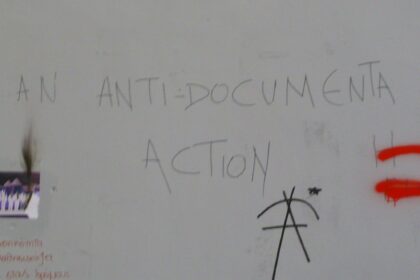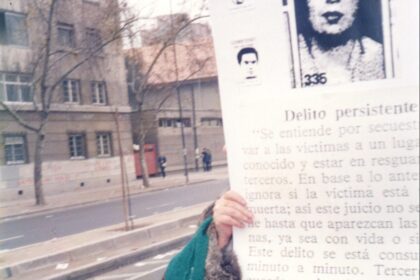Editorial | Winter 2023
FIELD Issue 23 is dedicated to the pioneering environmental art practice of Helen and Newton Harrison. The Harrisons were long-time faculty members in the Visual Arts department at UCSD, where FIELD is produced. The issue has been guest edited by Tatiana Sizonenko, who is also the project curator of an important retrospective exhibition, Helen and Newton Harrison: California Work, to be held at the La Jolla Historical Society (September 20, 2024-January 19, 2025). California Work has been funded by the Getty Foundation’s Pacific Standard Time initiative. This issue of FIELD was first envisioned as a compendium of papers presented as part of a public event held in La Jolla last March, intended to lay the groundwork for the exhibition. The event, “Listening to the Web of Life,” was attended by Newton Harrison, who was in fragile health at the time, and featured many of the key figures in contemporary environmental or ecological art practice. As the copy for this issue was undergoing an initial round of editing we learned the sad news that Newton had passed. As a result, the issue took on a new function; to both document the original proceedings and to honor the broader importance of the Harrisons’ legacy (Helen passed in 2019). For this reason, we’ve commissioned some additional remembrances from artists and curators who worked with the Harrisons in the past.
It’s difficult to over-estimate the foundational influence of the Harrisons’ work within the broader field of activist, environmental art. Certainly there is a broader history of important ecological art practice dating back to the 1960s, but the Harrisons are unique among the generation of artists who emerged at this time for their single-minded focus on issues of environmental sustainability and complex eco-systems, extending eventually to a global scale. They have, at this point, influenced several generations of subsequent artists, as the contributors to this special issue will attest. My own memories of the Harrisons began in the mid-1990s, when I encountered them at the important Littoral events, organized by Ian Hunter and Celia Larner in Manchester, England and Dún Laoghaire, Ireland. Hunter and Larner have played a key role in the evolution of rural-based art practices in the UK, and had a special affinity for the Harrisons’ work. Helen and Newton were charismatic, generous, and always attuned to the complex gestalt of the eco-systems around them. I was fortunate enough to engage with them again at UCSD when I arrived here in 2000. It was their openness and generosity, combined with an unyielding commitment to the preservation of the natural world, that provided the necessary frame for their ongoing, dialogical engagement with scientists, researchers, and the broader public, through a process which they aptly termed “conversational drift”.
This marks an important transformation in the ontology of contemporary art, as the locus of critical insight is displaced from the monadic consciousness of the artist (evident in the Conceptual art practices of contemporary figures such as Joseph Kosuth and Douglas Huebler) to the improvisational and aleatory exchanges that unfold within a provisional community of interlocutors and stakeholders. We encounter, as well, an interest in the creative potential of collaborative production in the formation of the “Harrisons” as a collective composed of two individual artists engaged in an ongoing dialogue that unfolds at the threshold between self and other. The Harrisons’ work also points to a decisive movement beyond the constraints of the institutional art world, with concrete proposals for environmental sustainability in the face of global climate change that found their interlocutors in government ministries and planning offices as well as galleries and museums. This shift is already anticipated in the Harrisons’ contribution to the landmark 1971 Art and Technology exhibition at LACMA, Shrimp Farm Survival Piece #2. It is symptomatic that one of the most generative projects in the entire exhibition was located outside the museum itself, in the LACMA courtyard. Shrimp Farm Survival Piece represented a clever play on the color field painting that would have been venerated on the walls of the nearby museum, but in this case it’s captivating hues were generated by the complex process of photosynthesis rather than the hand of the artist. The work simultaneously offers a subversive critique of the limitations of the institutional art world while also gesturing to the rich and unacknowledged forms of creativity and critical insight that can be generated beyond its precincts. FIELD would like to thank Tatiana, our contributors and the Harrisons’ family for allowing us to provide this platform. I want to conclude this introduction with a statement that was shared with us by Helen and Newton’s son, Josh, describing the vision of the Center for the Force Majeure, which was founded by Helen and Newton and is being carried forward by their children.
The legacy of Newton and Helen Harrison’s work continues on in the institution they founded: The Center for the Study of the Force Majeure. The Center looks at ways to address the impact of a warming planet at the scale it presents, from hyperlocal to global. Following the Harrisons’ vision of bringing our actions back into balance with the world in which we live, we seek to find ways to give back to the life web at least as much as we consume. The Center is actively engaged in bringing the Harrisons’ vision into place in locations all over the world. For more information please visit our website: https://www.centerforforcemajeure.org/
We are not apart from Nature; we are a part of Nature. This is a central contradiction of modern life. Our challenge as humans, activists, scientists and artists is bring us back into the system of which we are only a part.
—The Center for the Study of the Force Majeure











